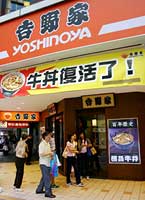|
|
|||||||
|
|
|||||||
|
|||||||
| | Web Japan >> | Trends in Japan >> | Business & Economy >> | Fast-Food Exports | |
|
FAST-FOOD EXPORTS Japanese Restaurant Chains Make Inroads in Asia (October 13, 2005) Walk the streets of Beijing and you are likely to see a jumble of billboards fronting a wide variety of fast-food restaurants. Look closely and you may spot an orange-colored board among the ones advertising the likes of McDonalds and Kentucky Fried Chicken. This is the sign for Yoshinoya, a Japanese chain of fast-food restaurants, which is quickly becoming a household name in China's capital city. As of the end of August 2005, the company had 67 restaurants in Beijing, in addition to 10 in Shanghai, 43 in Taiwan, and 23 in Hong Kong. Yoshinoya, whose flagship offering is gyudon (rice topped with fried beef and onion), is one of several Japanese restaurant chains making serious inroads throughout Asia. Curry, Coffee, and Ramen Diners in Hong Kong, meanwhile, now have the chance to sample the distinctive atmosphere and fare of izakaya, Japanese-style pubs, thanks to Monteroza, Inc., one of Japan's best-known izakaya operators. The company, whose domestic chains include Uotami and Shirokiya, has an outlet called Wara Wara located beside the Hong Kong Sogo department store. Encouraged by the restaurant's fast-growing popularity, the company is considering opening another branch by the end of this year in Shanghai. One of Monteroza's rivals, Watami, has also been busy setting up shop in Asia. It boasts restaurants in Hong Kong and mainland China and is planning to open at least 10 branches in Taiwan. Consumers in Asia are also developing a taste for coffee from Japan. UniCafé Inc., a Japanese coffee producer, established a joint venture with Mitsubishi Corp. and opened its first coffee shop, Amici Coffee, in Dalian, China. That is just the start, however, as the venture plans to create a franchise network with 100 coffee shops by 2010, beginning in late 2006. Meanwhile, Ichibanya is a Japanese chain of curry restaurants. Joining forces with House Foods Corp., it plans to open 10 branches in Shanghai within the next three years. Asian Potential The future of the Chinese market looks particularly bright. Many analysts believe that the Beijing Olympic Games in 2008 and the World Exposition two years later in Shanghai will give a huge boost to China's chain-restaurant market. Additional factors are an expected rise in the number of Chinese eating out due to rising standards of living, plus the increasing number of Japanese expatriates living in Chinese cities seeking a taste of home. Whether ramen or Japanese-style curry will be fully accepted by people living throughout Asia is yet to be determined. If they do, then these fast-food dishes may join sushi and tempura in becoming world-famous Japanese culinary exports. Copyright (c) 2005 Web Japan. Edited by Japan Echo Inc. based on domestic Japanese news sources. Articles presented here are offered for reference purposes and do not necessarily represent the policy or views of the Japanese Government. |
THE TASTES OF NAGOYA (July 19, 2005) FAST, CHEAP, AND SUDDENLY CHIC (September 11, 2000) |
|
|



